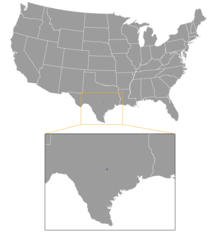Austin blind salamander
| Austin blind salamander | |
|---|---|
| Scientific classification | |
| Domain: | Eukaryota |
| Kingdom: | Animalia |
| Phylum: | Chordata |
| Class: | Amphibia |
| Order: | Urodela |
| Family: | Plethodontidae |
| Genus: | Eurycea |
| Species: | E. waterlooensis |
| Binomial name | |
| Eurycea waterlooensis | |

| |
| Austin Blind Salamander range[5] | |
The Austin blind salamander (Eurycea waterlooensis) is an endangered species of salamander in the family Plethodontidae, endemic to Barton Springs in Austin, Texas, United States.[1][6] Its name is derived from Waterloo, the original name of Austin.
Austin blind salamanders, typically juveniles, have been observed at spring outlets. However, probably most of the population lives in subterranean cavities, and its total abundance is unknown, but it seems much less abundant than the sympatric Barton Springs salamander (E. sosorum).[1]
It is a totally aquatic species that is paedomorphic (does not metamorphose).[1]
References
- ^ a b c d Geoffrey Hammerson (2004). "Eurycea waterlooensis". IUCN Red List of Threatened Species. 2004: e.T59278A11896000. doi:10.2305/IUCN.UK.2004.RLTS.T59278A11896000.en. Retrieved 16 November 2021.
- ^ "Austin blind Salamander (Eurycea waterlooensis)". Environmental Conservation Online System. U.S. Fish and Wildlife Service. Retrieved 4 May 2023.
- ^ 78 FR 5385
- ^ Hillis, D.M., Chamberlain, D.A., Wilcox, T.P., & Chippindale, P.T. (2001): A new species of subterranean blind salamander (Plethodontidae: Hemidactyliini: Eurycea: Typhlomolge) from Austin, Texas, and a systematic revision of central Texas paedomorphic salamanders. Herpetologica 57: 266-280
- ^ U.S. Geological Survey (2017). "Austin Blind Salamander (Eurycea waterlooensis) aABSAx_CONUS_2001v1 Range Map". Gap Analysis Project. doi:10.5066/F7S46R49.
- ^ Frost, Darrel R. (2014). "Eurycea waterlooensis Hillis, Chamberlain, Wilcox, and Chippindale, 2001". Amphibian Species of the World: an Online Reference. Version 6.0. American Museum of Natural History. Retrieved 14 February 2015.


